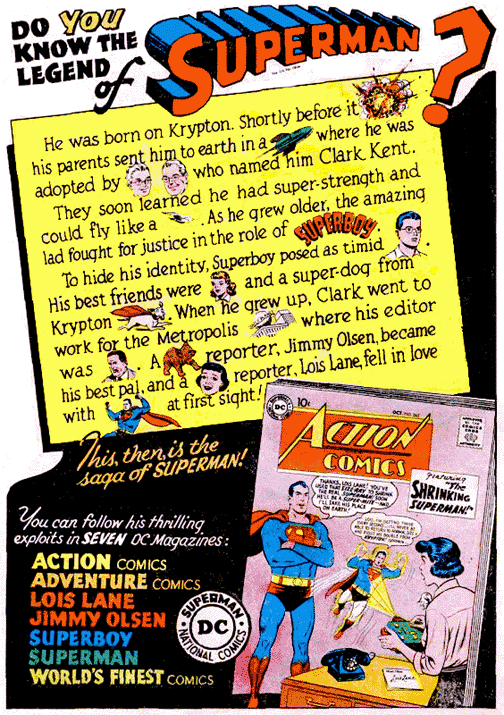Tagged: Superman
Mindy Newell: I Want To Believe
 Sometimes I think I’m living in a comic book world.
Sometimes I think I’m living in a comic book world.
Comics have often reflected the events going on in the real world. During World War II, American comics vilified the Axis Triumvirate, i.e., Germany, Italy, and Japan – Superman was fighting a German paratrooper on the cover of Action Comics #43, and Marvel (then known as Timely Comics) presented the All-American hero, Captain America, who, in a story written by and drawn by Joe Simon and Jack Kirby, punched out Adolf Hitler on the cover of his eponymous first issue, cover-dated March 1941. In Gleason’s Daredevil #1 (July 1941), the red-and-blue hero also took on the Führer, as did the Human Torch and The Sub-Mariner in the autumn of that same year.
The Boy Commandos, again from the team of Kirby and Simon working for DC, were four orphaned kids from the United States, England, France, and the Netherlands. They form an elite fighting unit under the command of Captain Rip Carter to fight the Nazis and appeared on the newsstands in the winter of1942. In Green Lantern #5 (May, 1945), the Emerald Crusader brings a bigoted Army private to Nazi Germany to show the private the rotten fruit of racism. Quality Comics’ Blackhawk first appeared in Military Comics #1, August 1941.
The Japanese didn’t get off easy. In The Nightmares Of Lieutenant Ichi or Juan Posong Gives Ichi The Midnight Jitters was published by U.S. Office of War Information for the Pacific Theater, and secretly circulated in the Philippines to boost morale during the Japanese occupation of country.
During the Korean War, the United States Department of State authorized the Johnstone and Cushing Company to create and publish the comic book Korea My Home, which was a true propaganda masterpiece worthy of Joseph Goebbels. In direct contrast, EC Comics debuted Frontline Combat and Two-Fisted Tales; these comics did not propagandize war as a “field of honor,” but showed the killing fields for what they were – im-not-so-ho, the real reason why EC Comics was attacked and shut down by Congress… although William Gaines, Al Feldstein, and Harvey Kurtzman, most notably, kept up the good fight by continuing to publish Mad Magazine, the “original” subversive comic magazine for us baby boomers.
But it’s all propaganda, whether you’re on the right or the left of the political 50-yard line.
During the Reagan administration (I have a picture in my mind of Ronnie in the Oval Office ignoring the beginning of the AIDS epidemic and dreaming up “trickle-down economics” and pulling the Marines out of Lebanon while giggling over the gang’s antics in Riverdale and munching on some jelly beans), the CIA got into the business of publishing comics – though it was credited to the fictional “Victims of International Communist Emissaries,” whoever the fuck they were supposed to be – in 1984 with Grenada: Rescued from Rape and Slavery.
Get this – the storyboards were delivered in a Washington, D.C. taxi, where the head of the company received a suitcase full of cash for them. Ooooh, James Bondian skullduggery! The comics were airdropped over Grenada prior to the American invasion of the island, and, according to Wikipedia, “were intended to justify the American intervention in the country by describing the rise of communist forces there and how their presence demands military intervention” and “outlines President Ronald Reagan’s justifications for the invasion: alleged oppression and torture of the local inhabitants, threats to American medical students on the island, and a potential domino effect leading to more Communist governments in the Caribbean.”
Also under Ronald Reagan – he who got away with the Iran-Contra scandal – and the CIA was the 1985 The Freedom Fighter’s Manual, distributed to the Nicaraguan Contras during the fight against the Sandinista government in that country.
This one if fucking unbelievable!
It states that its purpose is that of a “practical guide to liberating Nicaragua from oppression and misery by paralyzing the military-industrial complex of the traitorous Marxist state without having to use special tools and with minimal risk for the combatant,” and instructs the readers on all the “various techniques” the “guerilla fighter” can use to fight the oppressor, up to and including terrorism. Okay, it talked about non-violent protest (work slowdowns, wasting resources), but it also instructed the reader on “minor sabotage, how to set fires with makeshift time fuses, demonstrated the making of Molotov cocktails and using them to firebomb government buildings.”
It also is a political manifesto on the necessity and ultimate goal of guerilla warfare:
“…guerrilla warfare is essentially a political war. Therefore, its area of operations exceeds the territorial limits of conventional warfare, to penetrate the political entity itself: the political animal that Aristotle defined.”
This comic was repackaged and retitled “Afghanistan: The Mujahedeen’s Handbook for Overthrowing the Evil Empire” and redistributed to Osama Bin Laden’s team of freedom fighters in Kabul.
Only kidding!
Propaganda. It’s not just for kids anymore.
Marc Alan Fishman: Selling Out
 The other afternoon, whilst sipping on a cool beverage and shooting the breeze with a comic book making cohort, I stumbled upon a most interesting What If scenario. You see, this pal of mine loathes Kevin Smith (of Jay and Silent Bob, and a dozen other ventures). Knowing this, I pressed:
The other afternoon, whilst sipping on a cool beverage and shooting the breeze with a comic book making cohort, I stumbled upon a most interesting What If scenario. You see, this pal of mine loathes Kevin Smith (of Jay and Silent Bob, and a dozen other ventures). Knowing this, I pressed:
“What would you do if Kevin Smith got a hold of your [Amazing Indie Book I’ve Plugged Before], and decided he just had to turn it into a film. Would you make a deal with him?”
A little bit of hemming and hawing later, the answer was a resounding yes – pending a considerable amount of money was put on the table, as well as some subsidiary rights. It ultimately got me to question myself: Would I put aside my integrity as an artist if it meant a more lucrative life? Well, as much as I’d love to be able to side with the staving artists of the world, I’m a fat dude who loves a good Faberge egg omelet far more than resting on a pile of unsold ideas.
It’s oftentimes the pipe dream of the indie creator, is it not? Certainly Banky and McNeil of Chasing Amy had courted selling out as means to better ends, and no one looked down on them much. The fact is that we barnacles on the S.S. Comics may enter into the endeavor or making pulp for the masses with nothing more than good intentions to entertain, but there’s only so long that one can sustain the hobby without lucrative backing.
As I’ve detailed time and again: each issue of my Samurnauts series represents roughly 250 work hours from concept to completion. Three guys working full time jobs and maintaining contact with loved ones – like our fiancés, wives, and kids – put in those hours. While there’s no greater feeling in the world than seeing a complete stranger plunk down his hard earned cash for my comic, there’s no bigger dream then being able to sustain a career actually making the next issue.
If there were to be a fly on the wall when Shuster and Siegel were pitching Superman, do you think they were contemplating points on the backend when they signed their names on the dotted line? I doubt it. They sold the rights for $130 and a contract to produce more material, to the tune of $150,000 a year for the pair. Superman, of course, went on to become a radio show, a newspaper strip, a cartoon, a television program, and countless cartons of collectable crap. The creators would end up suing DC and other respective owners for a fairer cut for the rest of their natural lives. The notion was clear from the start: putting food on the table will trump a stiff upper lip every time.
When an artist is given carte blanche to see their truest work come to fruition, I’ve no doubt it will always be better than had it been built by a focus group. But there’s a reason why DC and Marvel hire known names to helm their biggest titles. They’re not in the business to take leaps of faith. In the best cases, one could argue that a collaboration between art and commerce leaves the most people happy. See The Avengers. And when it goes wrong, well, funny enough, no one is exactly blaming Eastman and Laird over Bay’s Ninja Turtles now, are they.
The notion of selling out was always troublesome to me. The thing is, the Million Dollar Man was right: Everyone has a price. But there will always be those creations we hold nearest to our hearts and feel the need to protect. I believe for most of us indie creators, our ideas are always on the table for sale because we pride ourselves in the ability to create more where they came from. The hope is when we’re well off enough we can afford to give life to those new ideas without the slimy hand of an unwanted third party. Left to their own devices, Green Day became Foxboro Hot Tubs and without any focus groups to get in the way… ended up sounding like Green Day (from 1968).
So, I say unto all those amidst the Artist Alleyways! You are free and clear to seek that big payday without fear of repercussion. For you see… the artist that pays his bills, and lives to see another day has plenty of integrity in my book.
Mindy Newell: Full Of Sound And Fury
First off, “I just think he’s hot.”
That’s a line from the end of Man Of Steel, which I watched again last night. And the captain who says it is right. Henry Cavill is – im-not-so-ho – hot. Extremely so. Perhaps more importantly, the man can act. Given a script that does not serve Mr. Cavill, in its, let’s say, frugality of characterization, exploration, and screen time of Kal-El alias Clark Kent actually being Kal-El alias Clark Kent, Mr. Cavill does a helluva job in conveying the confusion, loneliness, guilt, anger, and prickly emptiness inside this alien immigrant from Krypton.
The first time I saw it, I thought it sucked. This time, I thought, well, it doesn’t so much suck as it does come up empty, running on fumes instead of a full tank. And, no, it’s not because *gasp* Superman Kills Zod! *gasp* – which is what got so many bowels, including mine, in an uproar. Given the (truncated) emotional journey that Kal-El alias Clark Kent is on in the film, it’s – im-no-so-ho – the right action at the right time, for not only is Kal-El alias Clark Kent killing the warlord, he is also killing Kal-El the Kryptonian (and by inference, finally laying to rest the planet of Krypton) inside of him, killing the “otherness” that has haunted him all of his life. In that moment of final brutality, he transforms into Clark Kent alias Superman, born and raised in Kansas, U.S.A., and citizen of the planet Earth. As Clark Kent he will love Lois Lane; as Superman he will love Earth.
The problem with the film as I watched it the second time was that I had trouble staying awake to watch the very, very, very protracted battle scenes. Frankly, it got B-O-R-I-N-G. Director Zack Snyder, like George Lucas before him, is not interested in “what makes people tick.” He’s the toddler who knocks down his building blocks because it makes a big noise. He’s the kid with the Erector set building a giant John Deere crane that can knock down his Legos Empire State Building. He’s the adult ultimate SFX and CGI geek that is given a zillion dollars to play with.
And so in Man Of Steel we got an eternity of destruction played out before our eyes. We got IHOP and SEARS demolished real good. We got shockwaves of roiling dust clouds rolling across the Kansas plains. We got tidal waves sweeping across the Indian Ocean. We got F-16s and alien ships crashing to the ground. We got skyscrapers collapsing. We got pummeling and we got blood-and-guts – only there was very little blood and there was absolutely no guts. We got death without bodies.
It’s not really Zack Snyder’s fault. Nor is it the fault of so many young adults, mostly men, who have said to me, “Man Of Steel was so cool! The best part was the fight between Superman and Zod, and when Superman killed him, that was the best!” For they are all part of a generation that, as kids, saw the real towers fall down on television. Too young to really understand what was happening, too young to think about the political implications, too young to grasp the murky history of the Middle East and how it led to that moment, 9/11 and its aftermath, the televised “Shock and Awe,” was the ultimate video game, with explosions and lights, full of sound and fury, and signifying nothing.
They did not know that it was a tale told by an idiot.
And now Superman has a new power. An incredibly destructive and unstable power, to quote writer Geoff Johns. Because heat vision and telescopic vision and super-duper strength and invulnerability and x-ray vision and the ability to fly at super-sonic speeds and across space and into suns and to cross the time barrier just isn’t enough anymore.
Because, you know, all that stuff can get so B-O-R-I-N-G.
Mike Gold: Superhero Movies of the Ancients
Don’t you just hate it when work interferes with work? It’s a sure sign that you’re working too hard.
I am rarely accused of this. Nonetheless, it’s late Tuesday, my column goes up early Wednesday, and I’ve got more work stuff I’ve got to do. So, instead of the well-researched, rabid screaming think piece that surgically eviscerates the comic book world as we know it today, I’m going to share with you some stuff I love.
There was a time when comics fans were in touch with related media such as illustration art, pulp magazines, science fiction, old time radio and newspaper comic strips. This was a time that preceded the mega-million dollar superhero motion pictures in which many fans find their legitimacy. No, what we had were movie serials. Most of them preceded comic books per se, but not those media noted above that were our cultural forbearers. Some of these serials were a lot of fun. A couple were brilliant. Most were crap, but, to be fair, Sturgeon’s Revelation – 90% of anything is crap – is as vital today as it was when he stated it around 1958.
Keeping this in mind, and acknowledging one person’s crap might be another person’s holy grail, I want to share with you some of the heroic fantasy serials I deem worthy of attention.
 We’ll start with what I regard as the best superhero serial of them all: the above-illustrated Adventures of Captain Marvel. Well acted, well written, fairly faithful to the Fawcett comic book, and featuring special effects that were quite good for their time and minuscule budget.
We’ll start with what I regard as the best superhero serial of them all: the above-illustrated Adventures of Captain Marvel. Well acted, well written, fairly faithful to the Fawcett comic book, and featuring special effects that were quite good for their time and minuscule budget.
Whereas we’ve had a lot of other superhero serials, including the surprisingly well-made Spy Smasher (another Fawcett hero), the second-rate The Phantom, the third-rate Batman serials, and the god-it-truly-sucks Captain America serial, my second favorite are the two Superman serials, particularly the second, Atom Man Vs. Superman… Atom Man being none other than Lex Luthor. Superman was played by Kirk Alyn, who later had the lead in the pathetic Blackhawk serial (for one thing, the Blackhawk serial really didn’t have any air fight scenes). Noel Neill, who reprised the role in the 1950s teevee series, played Lois Lane.
 A lot of fans dislike these serials because the flying scenes were animated. Animated not like Ray Harryhausen, animated like Hanna-Barbera. I suspect kids in the late 1940s didn’t have a problem with it, as it really isn’t that bad. Ms. Neill was the perfect Lois, and she continues to hold that title to this day. Kirk Alyn was fine as Superman, kind of cute as Clark Kent, and in costume he looked better than anybody save Christopher Reeve. An oddity: Lex Luthor was played by Lyle Talbot, who also played Jim Gordon in the second Batman serial as well as a major part in The Vigilante serial, based on DC’s long-running Action Comics feature. He also appeared in an uncountable number of television shows.
A lot of fans dislike these serials because the flying scenes were animated. Animated not like Ray Harryhausen, animated like Hanna-Barbera. I suspect kids in the late 1940s didn’t have a problem with it, as it really isn’t that bad. Ms. Neill was the perfect Lois, and she continues to hold that title to this day. Kirk Alyn was fine as Superman, kind of cute as Clark Kent, and in costume he looked better than anybody save Christopher Reeve. An oddity: Lex Luthor was played by Lyle Talbot, who also played Jim Gordon in the second Batman serial as well as a major part in The Vigilante serial, based on DC’s long-running Action Comics feature. He also appeared in an uncountable number of television shows.
There’s more. A lot more. Really good ones such as The Shadow, The Spider, and the best of the bunch, Flash Gordon.
Next week.
Mindy Newell: Sephora Kicks Super-Ass!
“Beauty, to me, is about being comfortable in your own skin. That, or a kick-ass red lipstick.” – Gwyneth Paltrow
“I fought a killer and didn’t even smudge my makeup.” – Rose Pressey, Flip that Haunted House
After a fun time with my grandson – soon to be 14 months old! What’s that saying about time flying? – on Friday at Gymboree, I drove over to Sephora to buy some concealer for my 61 year-old under-eye bags and of course ended up spending too much money on other shit that I probably didn’t need and which I justified by telling myself that I hadn’t splurged on said self in a year so stop worrying and learn to love the bomb, as Kubrick so aptly put it.
Anyway, driving home I got to wondering about what kind of skin care and make-up the superheroes use.
There are dozens – hundreds? – of mascaras that claim to be waterproof (though I’ve never used one that stands up to the pool or the ocean) and that will stand up to the most exhausting and sweat-inducing workouts and ultra-triathlons. There are dozens – hundreds? – of foundations and blushes and lipsticks and eye shadows made by companies, from deluxe department store brands to those found on a drugstore carousel rack, that claim to “lasts all day!,” withstanding everything from a walk in a tropical monsoon in Mumbai to a passionate, epic 24 hour tumble between the sheets. And there dozens – hundreds? – of skin care products promising to turn back the clock and/or replace more invasive products like Botox or Juvaderm or – going all the way – cosmetic surgery.
So what does a superwoman wear while she’s pummeling – and being pummeled by – her equally meta-powered enemy? Surely Superman needs a little styling gel to keep those oh-so-sexy Kryptonian curls and waves mussed in just the right places?
After all, no super hero wants to be seen with puffy, dark-circled eyes and a turkey neck. Doesn’t inspire much confidence in the civilians to be seen looking “tired and drab” when you set out to stop the latest threat to Earth.
WHOOSH! The Flash needs help. Yeah, that – ahem – flashy red suit of his is designed to withstand the friction and wind he creates as he rushes to help, sometimes hitting velocities beyond the sound barrier. But what does he use to prevent the certain skin damage to his wind burned and chapped cheeks, chin, and lips?
Speaking of skin care, here’s some other meta-human types that could some help with their epidermis:
- The Thing. ‘Nuff said!
- Iron Man. “What?” you say. “Tony Stark is enclosed in technological armor. He doesn’t have to worry about sun exposure!” Yes, but it gets hot inside that face plate. After a hard day at the office, there’s nothing the man needs more than a really good skin care regimen to cleanse out those pores and remove the layer of dead cells. May I suggest a little exfoliation two to three days a week with an at-home peel?
- Power Girl: You do a good job covering up, Kara, but you’re forgetting that delicate skin in your décolletage area. I recommend a moisturizer with an anti-antioxidant ingredient (vitamins C and E, for instance) and a SPF factor of at least 25. But stay away from moisturizers containing retinoid or alpha hydroxy acids, because they can make your skin more sensitive to the sun and its photo aging properties, especially in the summer or in equatorial climates where the sun is always strong.
- Starfire: Lady, I know you’re an alien, and that orange skin indicates the presence of melanin which helps protect the skin from sun damage, but really! With that costume exposing more skin to photo aging than Bettie Page on a beach shoot, you are risking looking like a prune before you’re 30! Hey, I’m the first one to say flaunt it if you’ve got it, but – never mind the moisturizer, you must cover up if you don’t want to develop a raging case of melanoma!
If looking delectable and gorgeous is part of the “brand” of taking on super villains, do ultra-women deliberately choose to look their best as they beat the crap out of some megalomaniac with phasers and lasers or even “old-fashioned” dirty bombs and plans for world domination as a subtle means to throw their villains off their games? Think about it. Wouldn’t, say, Arcade, so taken with Storm’s exotic beauty, deliberately lower the level of “play” in his Murderworld so as the woman wouldn’t be too bruised or battered?
Or, on the other hand, would Diana’s Amazonian beauty, enhanced with the understated mineral powder foundation and bronzer, the finest kohl eyeliner, the warmest clay lipstick offered by the cosmeticians of Themiscrya, only work to throw Barbara Minerva, aka the Cheetah, into a jealous frenzy of the nth degree, giving her even more of an excuse to rip her talons into Wonder Woman’s face?
Maybe the Grecian powerhouse should rethink her look when she’s up against women who hate her.
Yeah, if I lived in the alternate realities of Marvel and DC and Image, et. al., and I was a smart marketing or R&D executive at Lancôme or MAC or Estee Lauder or Maybelline or Revlon or Urban Decay, et.al., I’d convince my bosses to develop a line of skin care products and make-up specifically tailored to the super set.
And if it’s good for them, just think of what it would do for us working slobs.
Talk about product placement!
Dennis O’Neil: Beginnings, Myths, & The Flash
I guess that now we know because – correct me if I’m wrong – last Tuesday we were all hunkered down in front of our television sets watching the latest addition to broadcast video’s superhero pantheon acquire his powers. ‘T’was lightning mixed with some other stuff that made the Flash the Flash.
Can we all just relax a bit?
We seem to have a need to know from whence we came, we noble mortals. Most of the word’s religions/mythologies have an “in the beginning” chapter and, funny thing, it doesn’t seem to matter much what the particulars of those creation myths are. A bird brings up a speck of mud from deep in a primordial ocean and that morphs into our planet; the earth emerging from the cracking of a cosmic egg; the dismemberment of a primordial being whose body parts become flora and fauna…and on and on and on. These tales and many, many more have all, at one time or another, sufficed to answer the question of our Beginnings. We seem to want to know our heroes’ origins, too, and so “origin stories” have been staples of comic books (which are what we’re concerned with here) from the first pages of the first appearance of the first mega-popular superhero and of course we could mean none other than Superman. That origin, as movie producer Michael Uslan pointed out decades ago, is quite similar to a story found in the Bible, and you can take that anywhere you want it to go.
Where were we? Ah, I remember: flashing.
The creators of the program under discussion chose to use science to explain how Barry Allen can move so darn fast. Nothing new: there have been four comic book iterations of The Scarlet Speedster and all owe their special traits to science… or maybe we should make that “science.” Briefly: Jay Garrick inhaled hard water vapors to acquire his power; Bart Allen got his after a sojourn in a time machine; Barry Allen and Wally West got their superspeed after being near a lightning bolt that struck some lab chemicals in two separate incidents. (And hey, you carpers – the word “coincidence” exists for a reason.) The teevee folk chose a variation of the Allen-West scenario.
There are, of course, other comics heroes who owe their uniqueness to “science” – we’re not forgetting The Hulk’s exposure to gamma rays, The Fantastic Four’s being zapped with cosmic rays, Spider Man’s encounter with a radio active spider and if you’ve a mind to, you can add your own favorites to the list, but I want to get back to the Flash.
If comics had existed before, oh, say, the Renaissance, our heroes powers would probably been explained by magic because, although science – without the quotation marks – existed back then, I doubt that the varlet on the street thought of it when he considered the miraculous. Magic, or contact with the Almighty, were what caused miracles to happen. Label something magic and… case closed. “Science” served the same purpose for comics (and pulp) writers. As suggested above, we mostly don’t care about the particulars of our origin stories, we just want them to exist.
Then: abracadabra. Now: quantum physics.
As for that label we use to explain the marvelous…we have to be careful if we plan to call it bogus. The nifty – and frustrating – thing about scientists is that they’re never absolutely sure of anything. They always allow for the possibility that they’re mistaken, that something will happen tomorrow that will completely invalidate what they “know.” Radioactive spider? Wellll…
Martha Thomases: The Comic Book Fan as Retailer
The New York Comic-Con is this week, which is hardly about comics at all anymore. It attracts more than a hundred thousand people to the unbearable Javits Center, all of them drawn to a celebration of pop culture, fantasy, and science fiction.
With all these people clearly interested in the genre, why do so few of them buy comics?
There isn’t one single answer, of course, but today I’m going to discuss the way the comic book publishers market their wares. Specifically, I’m going to talk about how they sell their books to retailers.
Comic books used to be distributed to the marketplace like other periodicals. The publishers would print and ship many more copies than they thought they could sell, ship them to newsstands and other outlets, and accept returns on the unsold copies. Because most comics and graphic novels are now distributed through the direct market, retailers order (and pay for) only the quantity they think they can sell.
Therefore, the primary customer for the publishers is the retailer and not the reader. The publisher does not care, in the short terms, if the retailer sells all the copies ordered. The publisher still gets paid. Of course, a thoughtful publisher will realize that selling the retailer too many copies will eventually cause the retailer to go bankrupt.
Too many publishers are not thoughtful. And too many retailers get into the business only because they love comics, not because they understand marketing. Or business.
If you read the (brilliant, I think) post in the link, you’ll see what information retailers are given to make their ordering decisions. He cites the example of Superman Unchained as a tragic lost opportunity. The book began at the same time the Man of Steel movie was released. It had Scott Snyder on script and Jim Lee on art. It should have been a huge hit.
Instead, it’s dribbling to a close.
The writer of the original post gives a lot of good reasons why he thinks this happened (bad title, unreliable scheduling). I think, if we step back, there are even more reasons.
The biggest problem is that the publisher thinks every possible customer is just like the retailer.
I love Scott Snyder as a writer, and I think Jim Lee’s art is dynamic and appealing. That said, I don’t think very many of the people who went to the movie know who either man is. Therefore, any new series designed to take advantage of the buzz about the movie needs to stress the character and the story more than the creative team.
The same is true for this summer’s bit Superman event, the Geoff Johns/John Romita, Jr. team. To comics fans this is great, but to the average person, a complete enigma. This is especially sad because I think Johns does a great job when he focuses on the most human and engaging aspects of the characters. His Superman is open and appealing to everyone, not just people who have been reading comics for decades.
And those people won’t ever know it, if the only way the title is promoted is to hype the creative team.
One of the biggest changes to happen to comics in my lifetime is that we now celebrate the talent. Fans know their favorite writers and artists, and will sample many different kinds of books because their favorites are involved. This is a terrific development. It shows the marketplace has matured, and allows creators to leverage their popularity into actual money.
The downside is when publishers think hiring great talent is all they need to do. Writers and artists can do fantastic work, but if the publishers don’t market these creations so that customers know what they are buying, it won’t matter.
Retailers have a responsibility as well. A well-promoted and designed store will invite in new customers and display merchandise in a way that is both fun and informative.
Consider other entertainment options that you purchase. When you decide to go to a movie, for example, you might consider the cast and, if you’re more involved, the director and the screenwriter. But first you want to know if it will make you laugh or cry, shiver with terror or clap your hands with delight. You want to know what kind of experience is being offered.
Comic book stores and comic book publishers who rely only on customers who are already customers will fail. We, as an industry, need to create new customers every day.
Or at least every Wednesday.
Marc Alan Fishman: Sex & Drugs & Rock N’ Roll & Child Raising!
The other evening I was frequenting my Facebook parents group and a post caught my eye. A mother had introduced her four year old to Batman. “Good for her!” I thought. She went on to say she was “horrified” by her son now calling her “stupid,” and to “zip her lip,” and he was becoming more prone to poking and fighting. She was fearful what she’d started in her son, and at any request to remove the Dark Knight from her kid’s clutches was met with tantrums a’ plenty. She turned to the group for support and advice. I couldn’t help myself…
What this mother faces with her tot is what I think many creators of all ages material – myself included – fear the most: parental disapproval. When the gatekeeper that stands between you and your target audience deems you inappropriate, the likelihood of a sale diminishes exponentially. It’s a fine line to skate.
Much like a stand-up making the promise to not work blue, an all ages creator is tasked with entertaining without crossing the ever-creeping line of acceptable limitations. That entails language, violence, adult themes, and sexual activity. Show a drop of blood, a hint of boob, a mention of drug usage, or a slander on any deity being honored today? Get out, and don’t let the door hit you on the keester on the way!
That being said, as a creator, I am first and foremost about the quality and maturity of the finished product, blind and deaf parents be damned.
When I think to my childhood – likely between the ages of perhaps seven or eigth through to 12 or 13 – the media that stands out as the most beloved all contained shades of brilliance beyond the bright colors and fart jokes. Shows like Exo-Squad, the Transformers, and Disney’s Gargoyles all layered mature themes between the animated lines. And while my parents weren’t apt to purchase comics for me, no doubt any number of titles published at that time dealt in the same sandbox with aplomb. Ultimately as a creator, my responsibility is always to the book, as I said abov because if a scene demands brutality, it’s my choice as a creator to show it. How I choose to do so is what separates me from someone unrestricted.
In far too many cases, it’s often those creators who think beyond the predictable who end up elevating themselves to a better class of creation. Forgive me for reaching high, but like Seinfeld has said “…working blue is easy. Telling the same joke without having to swear doesn’t make you better. It just makes you that more appealing to more people. And how is that bad?” At the end of the day, as a creator, I see it as my duty to seek that balance, to make a book where a thirty year old and an eight year old can find common ground. To layer bits of mature themes in between the action, in an attempt to elevate the prose to exist with depth beyond the Photoshopped effects. To ultimately entertain the widest audience possible, not for profit in the monetary sense, but the spiritual one.
On the flip side to this argument comes my parental side. You see, I’m not just a creator of books. I’m a creator of life. My two and a half year old is just starting to shape his personality. With it, come those pieces of media he loves so much that he can’t live a day (truth: one hour) without re-consuming ad nauseam. Sometimes, he has impeccable taste – like his love of Peter Gabriel and They Might Be Giants. And yes, he also loves things I just can’t seem to understand – for example, videos where they repeat the same sing-songy chant about the alphabet until I want to jam a finger straight through my brainstem. But with all of it, I can’t help but put myself in the shoes of that aforementioned mother. When my boy eventually catches a love for Batman (or any comic related property) and he begins to emulate the sights and sounds, do I panic? Simply put… not one bit.
My personal parenting motto (thankfully shared by my wife) is that it’s not the fault of the media, it’s the fault of the parent. Now, let’s be clear: I’m not a dunce. It’s inevitable that my child will emulate something I don’t want him to. And when I will eventually explain that to him, his kneejerk reaction will be to repeat the undesired action until I’m yanking my beard out in anger. But the fact remains that as the parent it’s my responsibility to consume what my child consumes and to then interject perspective before, during, and after the consumption.
I’m a firm believer that children are smarter than the world at large deems them to be. I’ve come to this firm belief every time I’ve told my son that an apple is actually a french fry and he hurls said fruit back at me at terminal velocity. When Bennett eventually stumbles upon something that would otherwise scar him emotionally, that’s the time Dad needs to be there to explain that the zombie werewolves on the moon were only computer made monsters. And he’ll then soon learn that The Doctor will outsmart them too. Natch.
The reality is that we can’t shield our children from the world at large. And thanks in large part to how easily media can be obtained and consumed now, there’s no fighting the tide. As both a creator and a father, I think I know how to sail through choppy waters. By being honest, by communicating in terms my son will understand, and by helping him sift through the silt to find the best pearls to enjo, I’m doing the job I was meant to do.
For the poor mother whose kid is storming throughout the house declaring a personal vendetta on crime? The response I left her on Facebook stands: It’s a phase that you’ll have to deal with. Next time, stick to Superman. Your son will have a much harder time flying.
(Editor’s note: the story about the kid who wrapped a towel around his neck, shouted “I’m Superman” and jumped out the window is apocryphal.)
Saturday Morning Cartoons: S is for Superman!
From Sesame Street in the Seventies, “S is for Superman”! Stop whatever you’re signed up for and see this stupendous story!





















